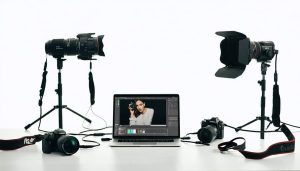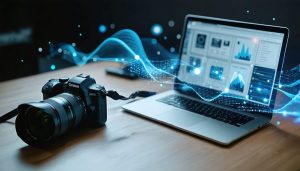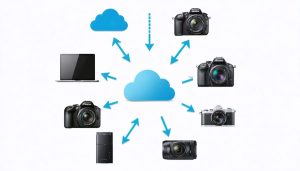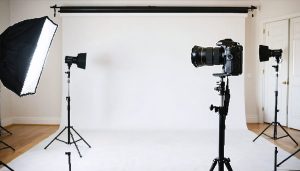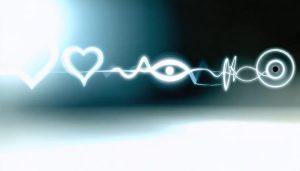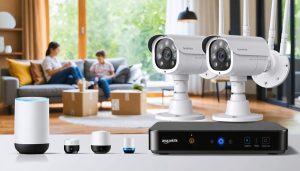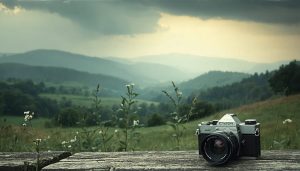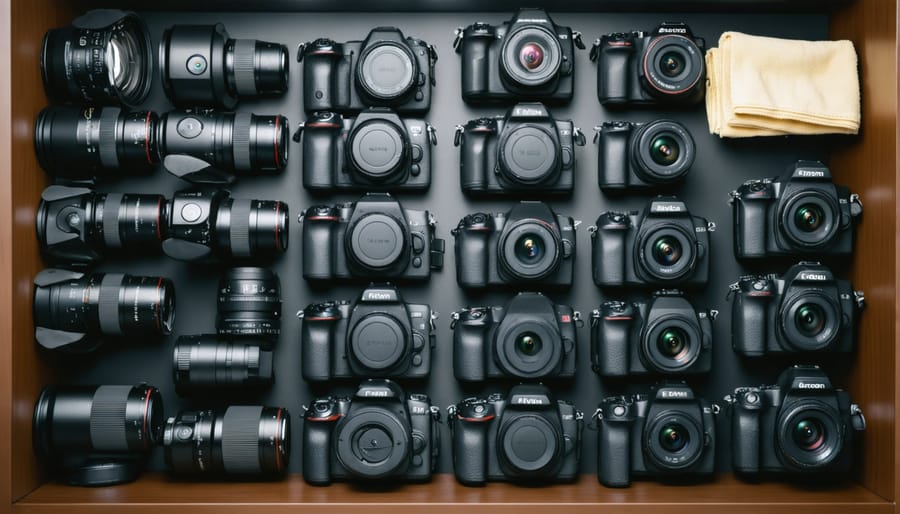
Track your camera gear’s market value through dedicated photography marketplaces and professional appraisal services, establishing a baseline for insurance and future resale opportunities. Professional equipment typically loses 30-40% of its value in the first year alone, making protecting your photography assets crucial for long-term investment.
Store cameras and lenses in climate-controlled environments with humidity levels between 35-45% to prevent internal deterioration and maintain optimal performance. Professional-grade weather sealing and protective filters become essential safeguards against accelerated depreciation in challenging shooting conditions.
Document all maintenance records, original packaging, and accessories – complete sets typically retain 15-20% more value than body-only sales. Regular sensor cleaning and mechanical servicing by authorized technicians preserve both functionality and resale value, offsetting the natural depreciation curve that affects even premium photography equipment.
Keep firmware updated and batteries properly cycled to ensure consistent performance, as documented maintenance history significantly impacts resale value in the professional market. Modern digital cameras depreciate faster than their film predecessors, making strategic timing of purchases and upgrades essential for managing equipment costs.
Understanding Photography Equipment Depreciation
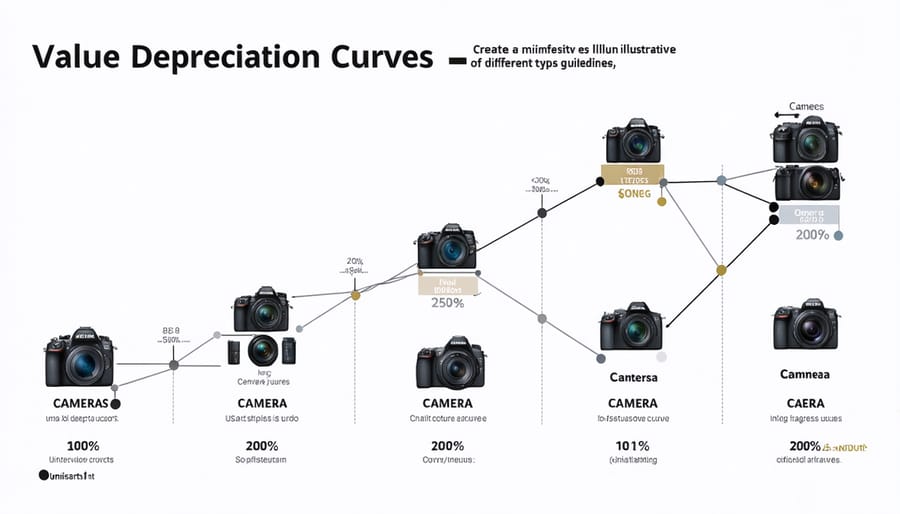
Normal vs. Accelerated Depreciation
Photography equipment, like most technology, naturally loses value over time. Normal depreciation follows a predictable pattern, typically 20-30% in the first year and 10-15% annually thereafter. This gradual decline reflects regular use and advancing technology in the market.
However, poor maintenance can accelerate this depreciation significantly. A well-maintained camera might retain 40-50% of its value after three years, while a poorly maintained one could drop to 20-25% in the same period. Think of it like a car – regular servicing and careful use preserve its value, while neglect leads to faster deterioration.
For example, a $3,000 professional camera that’s properly cared for might be worth $1,400 after three years under normal depreciation. The same camera, subjected to moisture damage, dust accumulation, or mechanical stress, could be worth as little as $700. This dramatic difference highlights why proper maintenance isn’t just about keeping your gear working – it’s about protecting your investment.
Consider this depreciation gap when deciding whether to invest time and resources in proper maintenance. The cost of regular cleaning and servicing often pays for itself in preserved value.
High-Risk Components
In the world of photography equipment, certain components tend to depreciate more rapidly than others. Digital sensors, being the heart of modern cameras, are particularly vulnerable to value loss due to continuous technological advancement. When newer sensors offer improved low-light performance and higher resolutions, older models quickly lose their appeal and market value.
LCD screens and electronic viewfinders also rank high on the depreciation list, as they’re prone to wear, dead pixels, and diminishing brightness over time. The mechanical shutter mechanism, typically rated for a specific number of actuations, becomes a significant concern for heavily used cameras, potentially affecting resale value.
Battery compartments and memory card slots are other critical areas that face wear and tear from frequent use. Additionally, lens mount mechanisms can develop issues over time, especially in cameras used for frequent lens changes. Electronic ports and connections, such as HDMI and USB interfaces, often become outdated as newer standards emerge.
Understanding these high-risk components helps photographers make informed decisions about equipment protection and maintenance priorities, potentially slowing the depreciation rate of their gear.
Maintenance Practices That Preserve Value
Regular Cleaning Protocols
Maintaining your photography equipment through regular cleaning not only preserves its value but also ensures optimal performance. Here’s a systematic approach to cleaning different types of gear:
For Camera Bodies:
1. Use a blower brush to remove loose dust and debris
2. Wipe the exterior with a microfiber cloth
3. Clean the LCD screen with a specialized screen cleaner
4. Use sensor cleaning swabs only when necessary, and consider professional cleaning for stubborn spots
For Lenses:
1. Start with a blower to remove loose particles
2. Gently brush the lens surface with a lens brush
3. Apply lens cleaning solution to a microfiber cloth (never directly to the lens)
4. Wipe in circular motions from center to edge
5. Clean lens contacts with isopropyl alcohol when needed
For Filters and Accessories:
1. Use the same gentle approach as with lenses
2. Pay special attention to threading and mounting points
3. Store with lens caps attached
Important Tips:
– Clean in a dust-free environment
– Never use compressed air on internal components
– Avoid touching glass surfaces with fingers
– Clean equipment after use in harsh conditions (beach, rain, dust)
– Keep cleaning supplies in your camera bag
– Document cleaning dates for warranty purposes
Remember, while regular maintenance is crucial, over-cleaning can potentially cause damage. When in doubt, consult a professional camera technician.
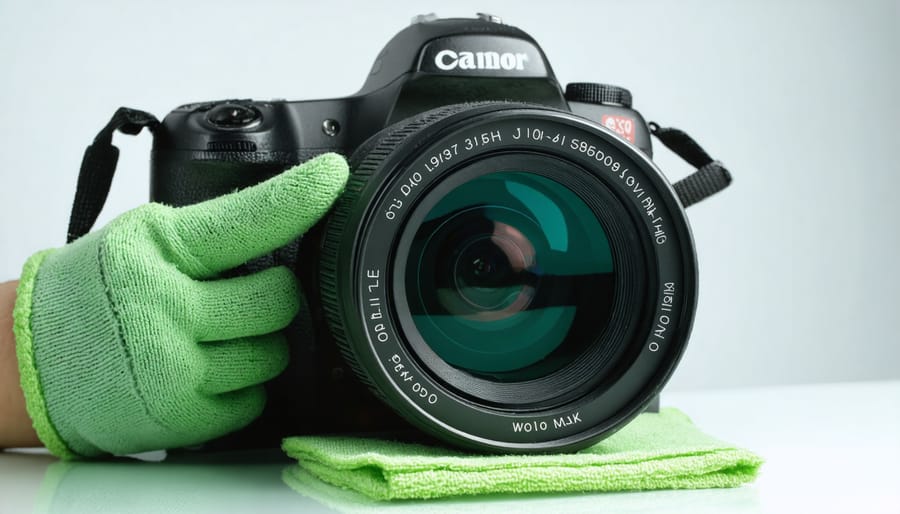
Storage Best Practices
Your photography gear deserves a safe haven, and establishing proper storage conditions is crucial for maintaining both its value and performance. Start by investing in a quality dry cabinet or dehumidifier-equipped storage space, maintaining humidity levels between 35-45%. This simple step prevents fungal growth on lenses and sensor corrosion, which can significantly impact your equipment’s longevity.
Store cameras and lenses in padded cases when not in use, and always keep lens caps on. Position gear upright rather than laying flat to prevent lubricants from pooling in one area. For batteries, remove them during extended storage periods and maintain a charge level around 40% to maximize their lifespan.
Temperature control is equally important – aim for a consistent environment between 60-70°F (15-21°C). Avoid storing equipment in basements, attics, or car trunks where temperature and humidity fluctuate dramatically. Keep gear away from direct sunlight and heat sources, which can deteriorate rubber components and adhesives.
Consider using silica gel packets in your storage containers to absorb excess moisture, replacing them every few months. For frequently used equipment, implement a rotation system to ensure even wear across your gear collection. Regular cleaning before storage prevents dust and debris from becoming permanent residents in your expensive equipment.
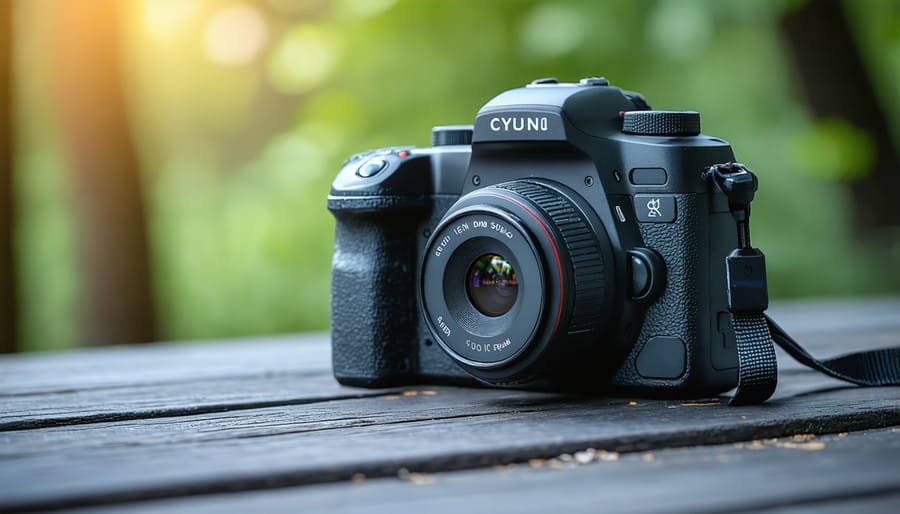
Professional Calibration’s Role in Value Retention
When to Seek Professional Calibration
Professional calibration is crucial for maintaining optimal camera performance and protecting your investment. While regular maintenance can be handled at home, certain signs indicate it’s time to seek professional calibration services.
Consider professional calibration annually if you’re a working photographer who relies on your equipment for income. For enthusiasts, every 18-24 months is typically sufficient unless you notice specific issues. Key indicators that warrant immediate calibration include inconsistent autofocus, unexplained exposure variations, or color accuracy problems that persist despite proper settings.
After significant impacts or environmental exposure (such as prolonged use in dusty or humid conditions), professional assessment becomes essential. Similarly, if you’ve recently acquired used equipment, scheduling a calibration can help establish a reliable performance baseline.
Keep detailed records of when your equipment was last calibrated and any changes in performance you notice. This documentation helps track patterns and anticipate when future calibrations might be needed. Many professional calibration services offer evaluation reports, which can be valuable for insurance purposes and tracking your equipment’s long-term condition.
Remember that the cost of regular calibration is minimal compared to the potential expense of replacing damaged equipment or losing client trust due to subpar image quality.
Cost-Benefit Analysis
When considering whether to invest in regular equipment calibration, photographers need to weigh the costs against potential benefits. Professional calibration services typically range from $50 to $200 per lens or camera body, depending on the service provider and equipment complexity. While this might seem substantial, especially for photographers with multiple pieces of gear, the long-term financial benefits often outweigh the initial investment.
Consider this: a well-maintained professional camera body can retain up to 40% more of its resale value compared to poorly maintained equipment. For instance, a $3,000 camera body might sell for $1,800 after two years with proper maintenance, versus $1,200 without regular care. This $600 difference alone justifies several calibration sessions.
Beyond monetary value, calibrated equipment delivers consistently better image quality, potentially leading to increased client satisfaction and more business opportunities for professional photographers. This improved performance can translate into higher booking rates and enhanced professional reputation.
However, not all equipment requires the same frequency of calibration. Entry-level gear might need less frequent servicing, while professional equipment used daily might benefit from bi-annual check-ups. The key is to establish a maintenance schedule that balances cost with your equipment’s usage patterns and revenue-generating potential.
Understanding and managing photography equipment depreciation is crucial for both hobbyists and professionals alike. By implementing the strategies discussed in this article, you can significantly slow down the depreciation rate of your valuable gear while maintaining its performance and resale value.
Remember that regular maintenance is your first line of defense against rapid depreciation. Clean your equipment after each use, store it properly in appropriate cases or bags, and protect it from extreme environmental conditions. These simple habits can extend your gear’s lifespan and preserve its value.
Documentation plays a vital role in maintaining equipment value. Keep all original packaging, manuals, and receipts. Maintain a detailed service history and track any repairs or professional maintenance. This documentation can significantly impact resale value when it’s time to upgrade.
Consider implementing a rotation strategy for your equipment. Use different pieces of gear regularly to prevent excessive wear on any single item. When purchasing new equipment, research market trends and opt for models with historically strong resale values.
Insurance and professional servicing shouldn’t be overlooked. While they represent additional costs, they protect your investment and can prevent costly repairs or replacements down the line.
Most importantly, balance the need to protect your equipment’s value with actually using and enjoying it. After all, photography gear is meant to be used to create beautiful images, not just sit pristine on a shelf.


